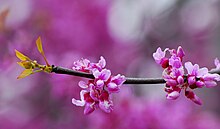| Cercis | |
|---|---|

| |
| C. siliquastrum (Judas tree) | |
| Scientific classification | |
| Kingdom: | Plantae |
| Clade: | Tracheophytes |
| Clade: | Angiosperms |
| Clade: | Eudicots |
| Clade: | Rosids |
| Order: | Fabales |
| Family: | Fabaceae |
| Subfamily: | Cercidoideae |
| Genus: | Cercis L.[1] |
| Type species | |
| Cercis siliquastrum L. (1753)
| |
| Species | |
|
10–24; see text | |
| Synonyms[2][3] | |
| |
Cercis /ˈsɜːrsɪs/[4] is a genus of about 10 species in the subfamily Cercidoideae of the pea family Fabaceae.[1] It contains small deciduous trees or large shrubs commonly known as redbuds in the USA.[5] They are characterised by simple, rounded to heart-shaped leaves and pinkish-red flowers borne in the early spring on bare leafless shoots, on both branches and trunk ("cauliflory"). The genus contains ten species, native to warm temperate regions of North America, southern Europe, western and central Asia, and China.[2]
Cercis is derived from the Greek word κερκις (kerkis) meaning "weaver's shuttle", which was applied by Theophrastus to C. siliquastrum[6] due to the resemblance of the dry seed pod to a loom shuttle.
Cercis species are used as food plants by the larvae of some Lepidoptera species including mouse moth and Automeris io (both recorded on eastern redbud). The bark of C. chinensis has been used in Chinese medicine as an antiseptic.[7]
Cercis fossils have been found that date to the Eocene.[8][9]
- ^ a b "Genus: Cercis L." Germplasm Resources Information Network. United States Department of Agriculture. 2011-04-17. Archived from the original on 2008-10-15. Retrieved 2011-09-28.
- ^ a b Ceratonia L. Plants of the World Online. Retrieved 15 August 2023.
- ^ Wunderlin RP. (2010). "Reorganization of the Cercideae (Fabaceae: Caesalpinioideae)" (PDF). Phytoneuron. 48: 1–5.
- ^ Sunset Western Garden Book, 1995:606–607
- ^ "Cercis". Integrated Taxonomic Information System. Retrieved 2011-09-28.
- ^ Quattrocchi, Umberto (2000). CRC World Dictionary of Plant Names. Vol. I: A-C. CRC Press. p. 485. ISBN 978-0-8493-2675-2.
- ^ redbud. (2008). In The Columbia Encyclopedia. Retrieved from http://www.credoreference.com/entry/columency/redbud
- ^ Jia H, Manchester SR (2014). "Fossil leaves and fruits of Cercis L. (Leguminosae) from the Eocene of western North America". International Journal of Plant Sciences. 175 (5): 601–612. doi:10.1086/675693. JSTOR 10.1086/675693. S2CID 84535035.
- ^ McNair, D.M.; D.Z. Stults; B. Axsmith; M.H. Alford; J.E. Starnes (2019). "Preliminary investigation of a diverse megafossil floral assemblage from the middle Miocene of southern Mississippi, USA" (PDF). Palaeontologia Electronica. 22 (2). doi:10.26879/906. S2CID 198410494.